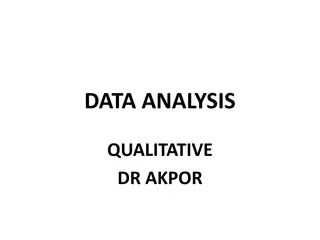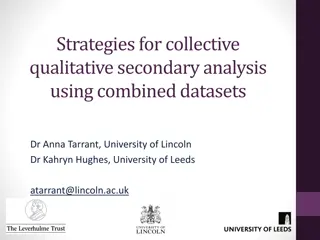
Qualitative and Quantitative Research Methods: A Comparative Analysis
Explore the differences between qualitative and quantitative research methods, including their approaches, data collection techniques, and analytical processes. Discover how each method offers unique insights into understanding human experiences and phenomena.
Download Presentation

Please find below an Image/Link to download the presentation.
The content on the website is provided AS IS for your information and personal use only. It may not be sold, licensed, or shared on other websites without obtaining consent from the author. If you encounter any issues during the download, it is possible that the publisher has removed the file from their server.
You are allowed to download the files provided on this website for personal or commercial use, subject to the condition that they are used lawfully. All files are the property of their respective owners.
The content on the website is provided AS IS for your information and personal use only. It may not be sold, licensed, or shared on other websites without obtaining consent from the author.
E N D
Presentation Transcript
INTRODUCTION TO QUALITATIVE METHODS ALANA NEWELL, PHD
THINKING ABOUT QUESTIONS How? Why, What? Does, Is, Can, Should?
COMPARINGAPPROACHES Quantitative Tests hypothesis that is constructed prior to data collection Mixed Methods Uses the strengths of one method to overcome the weaknesses of another Can generate and test a grounded theory Qualitative Responsive to changes that occur during the study; may shift focus Can explain how and why phenomena occur in the participants own words Emerging methods Can generalize findings when data are based on random samples of a sufficient size Pre-determined methods Instrument-based questions Both Both Open-ended questions
COMPARING APPROACHES Quantitative Research Statistical Analysis and interpretation Focuses on a relatively small number of concepts (concise and narrow) Qualitative Research Text and image analysis, theme and pattern interpretation Attempts to understand the phenomenon in its entirety, rather than focusing on specific concepts (complex and broad) Has few preconceived ideas and stresses the importance of people s interpretations of events and circumstances, rather than the researcher s interpretation Begins with preconceived ideas about how the concepts are interrelated
COMPARING APPROACHES Quantitative Research Collects information under conditions of control Qualitative Research Does not attempt to control the context of the research, but rather attempts to capture that context in its entirety Assumes that subjectivity is essential for the understanding of human experience Analyses narrative information in an organized but intuitive fashion Emphasizes objectivity in the collection and analysis of information Analyses numeric information through statistical procedures Investigator does not participate in the events under investigation is most likely to collect data from a real distance Involves sustained interaction with the people being studied in their own language and on their own turf
EXAMPLESOF QUALITATIVE DESIGNS Narrative research 1-2 individuals Researcher studies the lives of individuals Retells stories about lives chronologically Phenomenological research 3-10 individuals Studies events and occurrences from the experiences of individuals Researcher describes phenomenon from each perspective, tries to capture the different understandings, uncover meaning or essence
EXAMPLESOF QUALITATIVE DESIGNS Grounded Theory 20-30 individuals Systematic method of inquiry used to generate a theory about a phenomenon Has multiple stages of data collection; continues until a theory emerges from shared experiences Ethnography 1 culture-sharing group Exploration and documentation of shared patterns, language etc. in a shared culture Often involves observations and interviews Case Studies 4-5 individuals Researcher develops an in-depth analysis of a case: a program, event, activity or process Bounded by time; involves variety of data collection procedures
DATACOLLECTION Purposefully select participants Sample size depends on the research design; may start with a set number or move towards saturation - Data collection stops when new themes stop emerging Select data types
QUALITATIVE DATA - OBSERVATIONS Researcher takes field notes unstructured or semi-structured Can be concealed, observer only or a participant Generally open-ended with participants freely sharing their views
QUALITATIVE DATA - INTERVIEWS Researcher conducts face-to-face, telephone, online or focus group interviews Generally open-ended questions; may be semi-structured or unstructured
QUALITATIVE DATA - DOCUMENTS Researcher collects during process May be public (e.g., newspapers, meeting minutes, social media) or private (e.g., journals, letters)
QUALITATIVE DATA AUDIO/VISUAL Photos, videos, web pages, social media, audio recordings NOTE: unobtrusive, but can be difficult to interpret depending on source and context
QUALITATIVE DATA Synthesis of experiences, observations, and other sources Build descriptions of phenomena Iterative formation, development and modification of concepts and theories Categorize, classify (sort), ranked data Identify themes and examine their relationships
QUALITATIVE DATA ANALYSIS Analysis differs with each design, but there are several general steps Code Organize data Read through Themes Descriptions Interrelate themes or descriptions Repeat back as needed Interpret meanings
VALIDITYIN QUALITATIVE RESEARCH Assess that the findings are accurate: Triangulate data from different sources Member checking let respondents provide feedback on your interpretations Researcher bias clarify your background to help inform lens through which you interpreted findings Rich description provide information about setting and context Present discrepant findings External or peer reviewers allow others to ask questions and review your findings
QUESTIONS? Alana Newell, PhD adnewell@bcm.edu






















